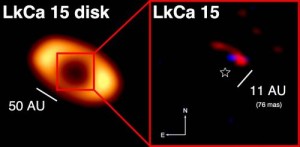US and Australian astronomers found youngest planet by cosmic trick photography
Friday, October 21st, 2011 8:15:53 by Zeeshan Gohar
US and Australian astronomers found youngest planet by cosmic trick photography
Astronomers from the University of Hawaii have captured the first direct image of a new planet forming around a star. The new found planet is dubbed as LkCa 15 b, the youngest planet so far. The astronomers captured it through cosmic trick photography combining the power of the 10-meter Keck telescopes with a bit of optical sleight of hand.
The newly formed LkCa 15 b looks like a hot protoplanet, which is surrounded by a swath of cooler dust and gas falling into the still-forming planet. The images of the planet taken by the astronomers reveal that the planet is nurturing inside a wide gap between the young parent star and an outer disk of dust.
Speaking about the formation of the planet, astronomer from the University of Hawaii’s Institute for Astronomy, Adam Kraus said, “LkCa 15 b is the youngest planet ever found, about 5 times younger than the previous record holder. This young gas giant is being built out of the dust and gas.”
Kraus added, “In the past, you couldn’t measure this kind of phenomenon because it’s happening so close to the star. But, for the first time, we’ve been able to directly measure the planet itself as well as the dusty matter around it.”
Kraus presented the discovery of the new planet on October 19 in a meeting at Goddard Space Flight Center, NASA. The meeting accepted the research paper, by Adam Kraus of Macquarie University and Michael Ireland of the Australian Astronomical Observatory, on the discovery of LkCa 15 b in The Astrophysical Journal.
Kraus further added to the discovery, “It’s like we have an array of small mirrors. We can manipulate the light and cancel out distortions.” With the help of aperture mask interferometry, the astronomers can cancel out the bright light of stars. This way, they can resolve dust disks surrounding the stars and can see spaces in the layers covered in that dust where protoplanets may be hiding.
Dr, Michael Ireland explained the technique, “Interferometry has actually been around since the 1800’s, but through the use of adaptive optics has only been able to reach nearby young suns for about the last 7 years. Since then we’ve been trying to push the technique to its limits using the biggest telescopes in the world, especially Keck.”
The discovery of LkCa 15 b was a part of a survey of 150 young dusty stars in star forming regions. The study led the astronomers to the more concentrated study of a dozen stars.
Short URL: https://www.newspakistan.pk/?p=1156

















